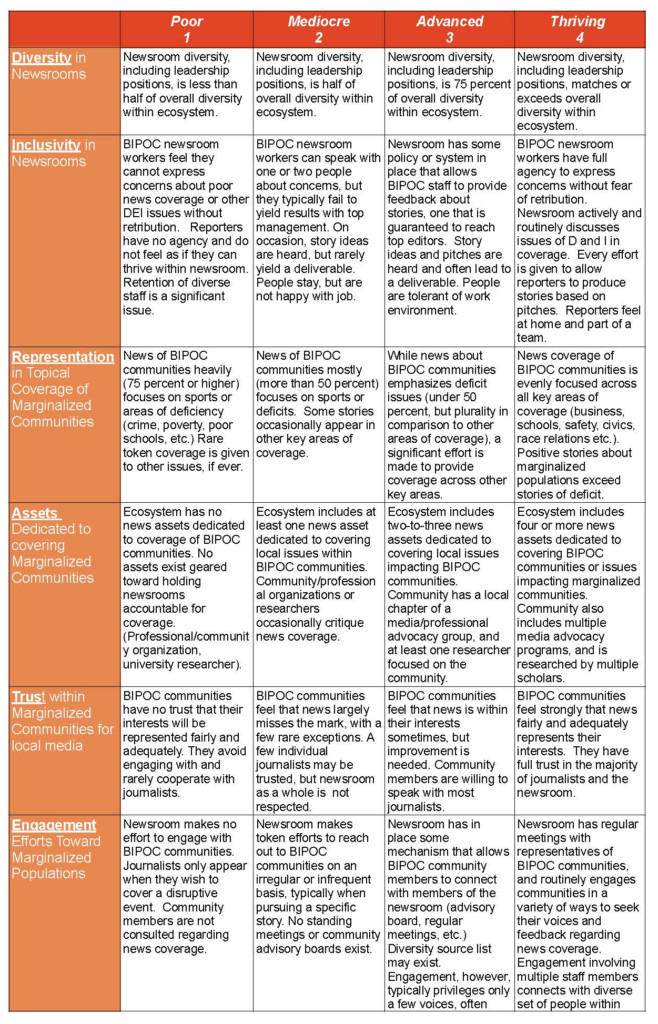Sign up for the daily CJR newsletter.
For decades, scholars have studied how systemically racist practices in the media have resulted in both stereotypical coverage of BIPOC communities and poor relationships with BIPOC community members. More recently, journalists of color have stepped forward to share their experiences with discrimination in newsrooms. And as the integrity of some of the country’s foremost media publications has come under fire, the visibility of racism in journalism continues to grow. Over the past year alone, we have heard horror stories about the lack of commitment in many newsrooms toward issues of diversity, equity, and inclusion. Groups including Free Press and several local chapters of the National Association of Black Journalists have actively led the charge in the past year to urge the industry to take a closer look at how it treats BIPOC communities both inside and outside of the newsroom.
We know newsrooms are not very diverse, particularly at the leadership level. We know BIPOC journalists do not feel as if they have a voice. We know newsrooms do a poor job of engaging audiences of color. And we know BIPOC communities do not trust most journalists.
We also know we need a better way of looking at and assessing the complexity of these issues. We need to find ways to allow newsrooms and those researching and examining media ecosystems to know exactly what they need to improve and build healthy relationships with BIPOC communities. This is where a rubric can help. By design, they provide clear guidance on how to properly and successfully complete an assignment. More often than not, rubrics assess for multiple criteria at the same time. Have a great lead, but not enough sources? The rubric details why the story wasn’t good enough and highlights what was necessary for it to be better.
Given the complexity of issues related to diversity, equity, and inclusion efforts across media, it makes sense to create an honest and simpler way to highlight problematic practices within newsrooms. Journalists, newsroom leaders, and researchers will be able to evaluate the exact factors that need to be addressed. The rubric will also provide some idea as to what standards need to be met to improve their workplaces and the industry at-large.
Such an assessment tool is long overdue. Over the years, even as we have paid more attention to issues of systemic racism, scholars and journalists haven’t always taken the best approaches in identifying and eradicating systemic racism from the news. The problem is so vast and complex that attempts at ad hoc solutions aren’t enough to truly challenge the system. When we approach newsrooms and ask them to change, too often the ensuing advocacy focuses on a single immediate issue. When an editor makes a mistake, calls are made for their termination. When a newsroom isn’t diverse, calls are made for more diversity. When news coverage isn’t fair, newsrooms are asked to take a closer look into how they report on and engage communities.
But all of these issues are connected, not isolated incidents of ignorance or racism. Still, in many cases, newsrooms haven’t given much thought on the systemic nature of their problems. And even if they know they have a problem, many lack even a basic understanding of how such issues manifest daily within their news gathering and storytelling practices. Some places, like the Philadelphia Inquirer and WHYY, have acknowledged it and recruited top researchers (such as Tow Fellow Andrea Wenzel) to study issues within their newsrooms. But in many–if not most–newsrooms throughout the country, leaders don’t know how to begin making such assessments nor do they have the resources to engage in in-depth critiques.
For the past two years, I have been developing this kind of rubric and using it with journalists and researchers seeking consultation for DEI issues. And thanks to a grant from the Media, Inequality, and Change Center at the University of Pennsylvania, I hope to publish a study detailing how the rubric can be used to assess both newsrooms and news ecosystems broadly. It’s not yet perfect. Other categories could certainly be added. And the rubric’s utility in academic research will be limited. But most importantly, in an ideal setting, we wouldn’t have to simplify systemic racism for people to pay attention to it. Even today, we are not (nor have we ever been) in an “ideal” situation when challenging people to take systemic racism seriously. But if keeping it simple is the nudge needed to start taking this pervasive injustice seriously, then that’s what needs to be done.
Has America ever needed a media defender more than now? Help us by joining CJR today.










